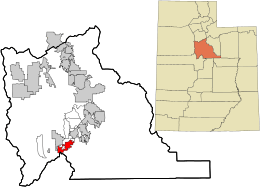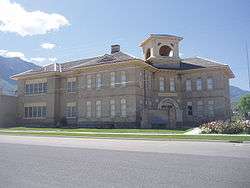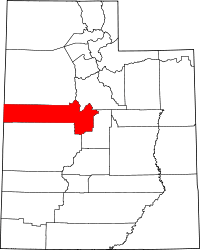Santaquin, Utah
| Santaquin, Utah | |
|---|---|
| City | |
|
Old Santaquin Elementary School is now The Santaquin Chieftain Museum | |
 Location in Utah County and the state of Utah | |
| Coordinates: 39°58′29″N 111°47′4″W / 39.97472°N 111.78444°WCoordinates: 39°58′29″N 111°47′4″W / 39.97472°N 111.78444°W | |
| Country | United States |
| State | Utah |
| Counties | Utah, Juab |
| Settled | 1851 |
| Incorporated | January 4, 1932 |
| Named for | a Ute chief |
| Area | |
| • Total | 2.6 sq mi (6.8 km2) |
| • Land | 2.6 sq mi (6.8 km2) |
| • Water | 0.0 sq mi (0.0 km2) |
| Elevation | 4,984 ft (1,519 m) |
| Population (2012) | |
| • Total | 9,674 |
| • Density | 1,848.8/sq mi (713.8/km2) |
| Time zone | Mountain (MST) (UTC-7) |
| • Summer (DST) | MDT (UTC-6) |
| ZIP code | 84655 |
| Area code(s) | 385, 801 |
| FIPS code | 49-67770[1] |
| GNIS feature ID | 1445329[2] |
| Website | www.Santaquin.org |
Santaquin is a city in Utah and Juab counties in the U.S. state of Utah. It is part of the Provo–Orem, Utah Metropolitan Statistical Area. The population was 9,128 at the 2010 census.[3]
Geography
According to the United States Census Bureau, the city has a total area of 2.6 square miles (6.8 km²), all land. It is located south-east of Utah Lake.
Climate
This climatic region is typified by large seasonal temperature differences, with warm to hot (and often humid) summers and cold (sometimes severely cold) winters. According to the Köppen Climate Classification system, Santaquin has a humid continental climate, abbreviated "Dfb" on climate maps.[4]
History
Santaquin, one of the early settlements along the Salt Lake Road, was originally settled in late 1851. It was originally named Summit City because of its location at the summit of the divide between Utah Valley and Juab Valley. Summit City was settled by pioneers who were helping settle nearby Payson to the north. In 1856 it was renamed Santaquin for the son of Guffich a local native chieftain friendly to the settlers.[5]
Demographics
| Historical population | |||
|---|---|---|---|
| Census | Pop. | %± | |
| 1860 | 158 | — | |
| 1870 | 602 | 281.0% | |
| 1880 | 715 | 18.8% | |
| 1890 | 769 | 7.6% | |
| 1900 | 889 | 15.6% | |
| 1910 | 915 | 2.9% | |
| 1920 | 976 | 6.7% | |
| 1930 | 1,115 | 14.2% | |
| 1940 | 1,297 | 16.3% | |
| 1950 | 1,214 | −6.4% | |
| 1960 | 1,183 | −2.6% | |
| 1970 | 1,236 | 4.5% | |
| 1980 | 2,175 | 76.0% | |
| 1990 | 2,386 | 9.7% | |
| 2000 | 4,834 | 102.6% | |
| 2010 | 9,128 | 88.8% | |
| Est. 2015 | 10,572 | [6] | 15.8% |
As of the census[1] of 2000, there were 4,834 people, 1,304 households, and 1,155 families residing in the city. The population density was 1,848.8 people per square mile (715.1/km²). There were 1,364 housing units at an average density of 521.7 per square mile (201.8/km²). The racial makeup of the city was 91.54% White, 0.17% African American, 0.62% Native American, 0.17% Asian, 0.06% Pacific Islander, 6.08% from other races, and 1.37% from two or more races. Hispanic or Latino of any race were 8.56% of the population.
There were 1,304 households out of which 61.1% had children under the age of 18 living with them, 77.8% were married couples living together, 7.5% had a female householder with no husband present, and 11.4% were non-families. 9.3% of all households were made up of individuals and 4.0% had someone living alone who was 65 years of age or older. The average household size was 3.71 and the average family size was 3.97.
In the city the population was spread out with 42.3% under the age of 18, 11.3% from 18 to 24, 29.1% from 25 to 44, 12.4% from 45 to 64, and 4.9% who were 65 years of age or older. The median age was 23 years. For every 100 females there were 105.3 males. For every 100 females age 18 and over, there were 99.6 males.
The median income for a household in the city was $44,531, and the median income for a family was $45,323. Males had a median income of $35,076 versus $20,581 for females. The per capita income for the city was $13,725. About 1.9% of families and 2.2% of the population were below the poverty line, including 1.6% of those under age 18 and 6.1% of those age 65 or over.
Main Street has a few stores and restaurants but no big-box stores.
Notable people
- Gary Coleman, (1968–2010), actor
- Andy Stevenson, (1997–), filmmaker[8]
Orchard Days
Orchard Days is Santaquin City's yearly celebration. Orchard days is a week long celebration with a multitude of activities including a parade, rodeo, carnival, savanger hunt, and several other family friendly activities. The Festival follows the general Utah norm of municipal celebrations. Festivals such as Orchard Days are great ways to get to know the community.
References
- 1 2 "American FactFinder". United States Census Bureau. Retrieved 2008-01-31.
- ↑ "US Board on Geographic Names". United States Geological Survey. 2007-10-25. Retrieved 2008-01-31.
- ↑ Bureau, U.S. Census. "American FactFinder". Retrieved 24 October 2016.
- ↑ "Santaquin, Utah Köppen Climate Classification (Weatherbase)". Retrieved 24 October 2016.
- ↑ Source: Myron V. Olson, compiler, “Give Me This Mountain, A History of the Santaquin Utah Stake,” 1984 quoted in Santaquin History, from santaquin.org accessed April 14, 2015.
- ↑ "Annual Estimates of the Resident Population for Incorporated Places: April 1, 2010 to July 1, 2015". Retrieved July 2, 2016.
- ↑ "Census of Population and Housing". Census.gov. Retrieved June 4, 2015.
- ↑ Hardy, Rodger L. (July 27, 2005). "Santaquin abuzz about new resident". Deseret News. Retrieved June 21, 2009.
External links
-
 Santaquin travel guide from Wikivoyage
Santaquin travel guide from Wikivoyage - City Website
 |
Genola | American Fork Utah Lake |
Payson |  |
| |
||||
| ||||
| | ||||
| Rocky Ridge | Fountain Green | Fairview, Scofield |


